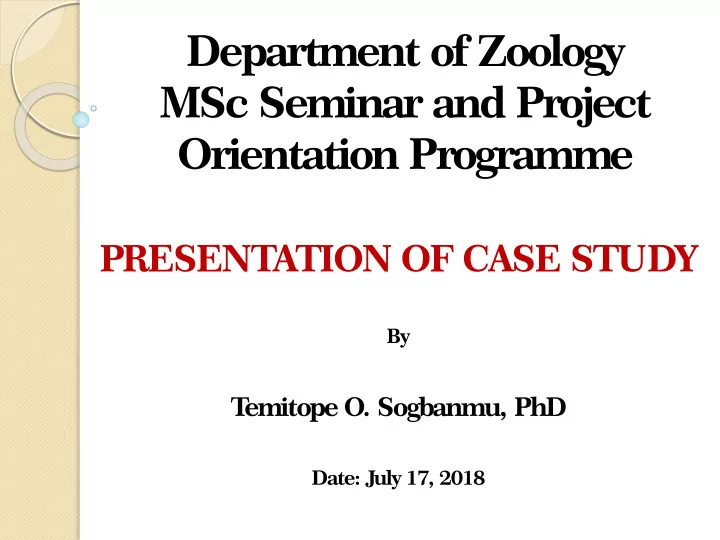

Department of Zoology MSc Seminar and Project Orientation Programme PRESENTATION OF CASE STUDY By T emitope O. Sogbanmu, PhD Date: July 17, 2018
Case Study ❑ A case study in the context of seminar presentation; ❑ a research article (published in a peer- reviewed journal) ❑ explains / expounds on the seminar topic ❑ should be selected based on local (department, Lagos, Nigeria, … ) first before regional or foreign/int’l examples. April 12, 2020 Presentation of Case Study 2
Seminar Example T opic: V olatile Organic Compounds in Indoor Environments April 12, 2020 Presentation of Case Study 3
Case Study 1 Title: Influence of V olatile Organic Solvents’ Inhalation on Activity Quotient and Biochemical Indices of Mus musculus Author(s): Akpan et al. 2012 Aim(s) of the study : to evaluate the effects of volatile organic solvents (xylene, thinner , and gasoline) inhalation on biochemical indices and activity in Mus musculus (laboratory mice) April 12, 2020 Presentation of Case Study 4
Case Study 1, Cont’d Methods: ❑ A modified nose inhalation exposure method was used. ❑ Exposure chambers were saturated with the test chemicals ( xylene, nitrocellulose thinner and gasoline ) for 8 h daily following which they were transferred to the vapour- free section of the chamber . ❑ Exposure / study duration: 60 days ❑ Average values for activity quotient were evaluated at days 21, 45 and 60 April 12, 2020 Presentation of Case Study 5
Case Study 1, Cont’d Methods: ❑ Liver samples were obtained from exposed and control mice at days 21, 45 and 60 for biochemical studies ❑ Activity quotient was determined thus; AQ = body movement per min Qty of feed consumed ❑ Biochemical indices evaluated were malondialdehyde ( MDA ), reduced gluthathione ( GSH ), superoxide dismutase ( SOD ) and catalase ( CAT ). April 12, 2020 Presentation of Case Study 6
Case Study 1, Cont’d Results: Figure 1: Activity quotient of control and exposed mice over a period of 60 days April 12, 2020 Presentation of Case Study 7
Case Study 1, Cont’d Results, Cont’d : Biochemical indices in the exposed and control mice; - significant decrease (p<0.05) in the levels of antioxidant enzymes such as reduced gluthathione ( GSH ), superoxide dismutase ( SOD ) and catalase ( CAT ) in exposed mice from day 21 to 60 compared to control. - the level of lipid peroxidation indicated by malondialdehyde ( MDA ) was significantly higher (p<0.05) in exposed mice compared to control. April 12, 2020 Presentation of Case Study 8
Case Study 1, Cont’d Conclusion ❑ W orkers who are exposed to these volatile organic solvents for elongated periods may be at risk of liver related disorders . ❑ There is a need for sensitisation and awareness programmes on the use of appropriate personal protection equipment (PPE) and reducing exposure through reduced-time shift regimes. April 12, 2020 Presentation of Case Study 9
April 12, 2020 Presentation of Case Study 10
Recommend
More recommend